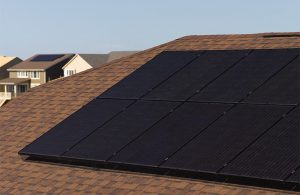Study finds wildfire smoke can reduce solar panel output by nearly 50%


Dr. Long Zhao and his graduate student Amjad Ali are shown here on the campus of South Dakota Mines during their research examining the impact of wildfire smoke on solar energy generation.
Wildfire smoke may have a significant impact on the efficiency of solar panels and the overall effort to transition nation’s energy production from fossil fuels to more solar based systems, according to research published by Long Zhao, Ph.D., an assistant professor in the Department of Electrical Engineering and Computer Science at South Dakota Mines and director of the Smart Grid and Energy Research Lab at South Dakota Mines.
Zhao’s work, conducted over the last two years when wildfire smoke blanketed parts of the American West, shows that widespread smoke can reduce the output of individual solar panels by nearly 50% — even on days when smoke is present at high altitudes and air quality near the ground is not significantly impacted.
It makes sense that solar energy production is negatively impacted on very smoky days, but Zhao’s team was surprised to see reductions in solar energy output when wildfire smoke was aloft higher in atmosphere.
“This makes it harder to quantify days when smoke will impact solar energy production based on air quality monitoring systems we have in place,” Zhao said. His work will be published in the Journal IEEE Transactions on Industry Applications.
Unlike passing clouds that can reduce solar energy generation for a short duration, wildfire smoke can settle over a region for an extended period. This summer, for example, saw thick layers of Canadian wildfire smoke inundate the East Coast of the United States.
“I think one special thing about wildfire smoke is it can travel thousands of miles and cover lots of land mass and last for days or even weeks,” said Zhao.
Smoke from wildfires often varies in intensity with pockets of heavier and lighter coverage that can cause fluctuations in solar panel output. Zhao calls these fluctuations “the wiggle effect,” and he described this phenomena in a paper published by IEEE that was shared in the publication IEEE Spectrum.
“These fluctuations can have a significant impact on our power supply if we are relying on solar systems as a major part of our energy grid,” says Zhao.
Electric grids across the nation operate on thin margins between supply and demand, and Zhao’s work shows fluctuations in solar energy generation caused by wildfire smoke could be enough to destabilize parts of the grid that are more reliant on solar power.
“Bigger photovoltaic systems will have bigger problems with the wiggle effect,” Zhao says. “We have not yet seen widespread problems because we do not yet have solar widely installed across the country. As we move to rely on more solar power in the future, and as wildfires continue, this is going to be a serious problem we need to address.”
The wildfire smoke research was supported by the Edwin E. Clark Professorship through the South Dakota Mines Center for Alumni Relations and Advancement (CARA).
Zhao is seeking graduate students and more funding for his ongoing research.
News item from South Dakota Mines





